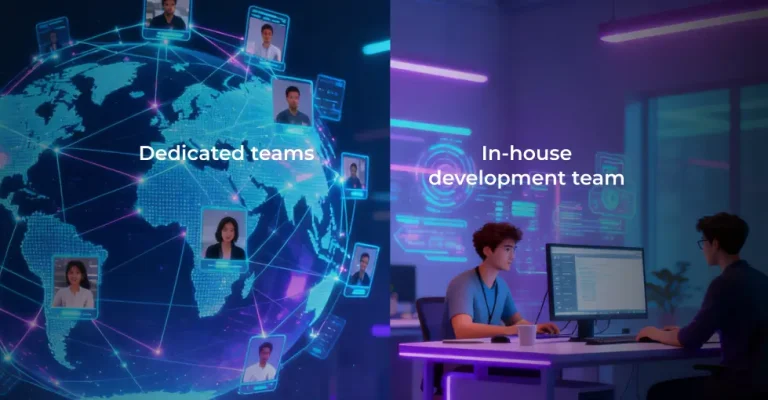Hiring a dedicated development team in Eastern Europe is a popular strategy for companies aiming to scale their software projects efficiently and cost-effectively. Businesses get access to talents who work exclusively on their projects, bringing both focus and speed. With competitive rates, strong technical expertise, and time-zone compatibility with Western markets, Eastern Europe stands out as a reliable outsourcing destination for a wide range of projects: mobile app development to AI.
What is a dedicated development team?
A dedicated development team is an outsourced group of software professionals — engineers, designers, QA specialists, and project managers — who work exclusively on one client’s product, typically for an extended period. Unlike traditional outsourcing, where teams may handle multiple clients, dedicated teams function as a full-time extension of your in-house staff. They integrate into your workflows, adopt your processes, and stay aligned with your product roadmap.
This model provides three key advantages:
- Continuity: The team builds long-term product knowledge, ensuring smoother iterations and fewer handovers.
- Flexibility: Companies can scale resources up or down depending on project phases, without the commitments of in-house hiring.
- Cost efficiency: By leveraging global talent markets, businesses reduce overhead related to salaries, benefits, and infrastructure.
Dedicated teams can operate remotely (nearshore or offshore), but in all cases, their main priority is driving the client’s product forward with focus and alignment.
Dedicated team vs. staff augmentation vs. freelance vs. managed services vs. building your own R&D center
Different cooperation models serve different business goals. Some are better for long-term strategic development, others for short-term needs or ongoing support. Here’s a side-by-side overview of how they compare:
| Criteria | Dedicated teams | Staff augmentation | Freelance | Managed services | Own R&D center |
|---|---|---|---|---|---|
| Talent selection & vetting | Vendor recruits and vets, client has final say | Vendor provides profiles, client makes final choice | Fully client-driven | Fully vendor-driven, with limited client input | Fully client-driven, requires own HR/TA team |
| Level of autonomy | High: client sets priorities and vendor manages delivery | High, with client managing day-to-day work | High, with support for client oversight | Low: vendor controls execution end-to-end | Very high: complete ownership by client |
| Type of resources | Full-time teams reporting to client | Individual experts embedded into client’s team | Independent contractors, often part-time | Fully managed vendor teams | In-house employees |
| Type of engagement | Full-time, typically medium or long-term | Typically full-time, with flexible duration | Project-based or part-time, multiple clients | Service contract with fixed scope | Long-term, full-time engagement |
| Integration into client team | Strong – aligned with client culture, processes, and tools | Moderate – depends on contract length and turnover | Low – limited alignment, often siloed | Low – vendor follows own methodologies | High – fully aligned as client’s internal resources |
| Communication | Typically follows client protocols and managed by vendor | Typically follows client protocols with support from vendor | Client is fully responsible for managing communication flows | Vendor-led, with regular updates | Internal and fully managed by client |
| Reporting | Managed by vendor and aligned with client needs | Based on client’s reporting protocols | Client-led, with support from freelancing platforms | Managed by vendor and aligned with client needs | Fully managed by the client |
Talent retention & upskilling | Retention, training, and career growth supported by vendor | Client typically owns project retention, with motivation and upskilling handled by vendor | None: freelancers rotate frequently | Vendor fully handles retention and upskilling | Client must invest heavily in retention, training, HR policies |
Independent contractor vs full-time equivalent (FTE) cost considerations
Choosing between contractors and FTEs depends on project length, stability, and need for cohesion:
- Independent contractors often charge higher hourly rates but provide flexibility for short-term or project-based work without long-term commitments or overhead costs such as benefits, taxes, and equipment.
- Full-time equivalents (FTEs) typically cost less monthly when considering consistent workloads, providing greater continuity, team integration, and loyalty.Still, they require commitments for salaries, benefits, infrastructure, and legal compliance.
- Choosing between contractors and FTEs depends on project length, budget stability, and the need for team cohesion.
Signals that a dedicated team is the right choice for your project
- You need full-time focus on your product, not task-based delivery.
- Your roadmap involves evolving requirements and demands flexible scaling.
- You want direct integration with your workflows, tools, and culture.
- Long-term continuity and product knowledge are essential for success.
- You expect structured communication and close alignment with your team.
- Cost efficiency matters, but not at the expense of quality and stability.
- You’d rather extend your team than take on the overhead of building an R&D center.
Why choose Eastern Europe: benefits & business case
The IT outsourcing market in Eastern Europe is experiencing remarkable growth, with revenues projected to reach $5.34 billion in 2025 and continuing to expand at an annual rate of 6.82%, aiming for nearly $7.43 billion by 2030.
![Stacked bar chart showing IT outsourcing market growth by segment from 2016 to 2028]](https://agileengine.com/wp-content/uploads/2025/09/Hiring-a-Dedicated-Development-Team-in-Eastern-Europe-1024x414.png)
Source: Statista Market Insights
This momentum is driven by a mix of world-class technical talent, cost efficiencies, and favorable business environments that make the region increasingly attractive for global companies.
Cost savings and expected ranges
Eastern Europe continues to stand out as a cost-effective destination for IT outsourcing, offering significant savings without sacrificing quality or expertise. Recent data shows that companies can reduce operational costs by up to 60% compared to US-based teams, while gaining access to a vast pool of skilled specialists with strong technical and cultural alignment to Western markets.
Hiring developers in key countries like Poland, Ukraine, Romania, and Bulgaria can bring substantial cost benefits, especially in high-demand areas such as AI, data science, and mobile development, where salary savings can reach as high as 68–72% compared to Western Europe or the US.
Access to deep technical expertise & STEM graduates
Eastern Europe’s strength lies in its solid foundation of STEM education, driven by investments and reforms inspired by broader EU initiatives.
The region benefits from a strong tradition of science, technology, engineering, and math education. Countries like Estonia, Lithuania, Poland, and Hungary boast over 50% of upper secondary vocational graduates specializing in STEM fields — ahead of the EU average of 37.4%.
Around 25.8% of university graduates across the EU are in STEM, with Eastern European nations growing their share through curriculum modernization, teacher training, and industry collaboration. Ongoing investments (including more than €127 billion in EU Recovery and Resilience Plans focused on digital skills) help sustain and expand this talent base.
Vast talent pool
The region’s leading universities such as Warsaw University of Technology, Taras Shevchenko National University of Kyiv, and Czech Technical University in Prague consistently rank in the QS World University Rankings.
Practical training through coding schools and bootcamps — like Coders Lab in Poland and Skylab Coders Academy in Ukraine — further strengthens developers’ skills. Combined with ongoing investments in digital education and curriculum modernization, Eastern Europe offers a steady pipeline of highly qualified tech professionals ready to support global software projects.
| Country | Number of developers | Number of ICT graduates |
|---|---|---|
| Ukraine | 363,000 | 27,000 |
| Poland | 525,000 | 68,000 |
| Romania | 200,000 | 7,000 |
| Czech Republic | 100,000 | 24,000 |
| Hungary | 80,000 | 3,000 |
| Bulgaria | 67,000 | 2,300 |
| Moldova | 13,000 | 2,000 |
Time-zone and communication advantages
Eastern Europe’s geographic location creates valuable time-zone overlaps and communication efficiencies that optimize collaboration with US-based teams.
- Benefits for US East Coast companies: Eastern European countries operate primarily in CET (UTC+1) and EET (UTC+2) zones, creating a 3 to 6-hour overlap with the US East Coast workday. This overlap facilitates real-time communication, synchronizes meetings, and supports agile workflows where feedback can be exchanged without delay.
- Benefits for US West Coast companies: The 9-hour or more time difference between Eastern Europe and the US West Coast enables near 24/7 development cycles. While the West Coast team ends their day, the Eastern European teams just begin theirs. This effectively extends operational hours, allowing work and progress to continue seamlessly around the clock, boosting productivity and speed to market.
| Country | Time zone | Offset |
|---|---|---|
| Ukraine | EEST | GMT+2 / GMT+3 |
| Poland | CEST | GMT+1 / GMT+2 |
| Romania | CEST | GMT+2 / GMT+3 |
| Czech Republic | CEST | GMT+1 / GMT+2 |
| Hungary | CEST | GMT+1 / GMT+2 |
| Bulgaria | EEST | GMT+2 / GMT+3 |
| Moldova | EEST | GMT+2 / GMT+3 |
Communication advantages
Eastern Europe boasts high English proficiency levels, with countries like Poland, Czech Republic, and Hungary ranking in the top tiers of English skills within Europe. According to EF English Proficiency Index 2024, many CEE countries fall into “very high” or “high” categories, ensuring smooth, clear communication.
Combined with over two decades of outsourcing experience, this has ingrained Western work ethics, agile methodologies, and collaborative workflows deeply into the IT workforce’s culture.
Business-friendly regulatory and tax environments
Eastern Europe provides more favorable tax environments relative to the US, where combined corporate tax rates often exceed 25–30%. For example, Bulgaria has a flat 10% corporate tax rate, Hungary 9%, Poland 19%, and Romania 16% — all substantially lower than the US federal and average state rates.
Additionally, EU membership ensures regulatory stability and alignment with GDPR and IP protections, giving companies a transparent, secure, and cost-effective framework for operations.
Scalability and speed to hire
Thanks to its well-established outsourcing ecosystem and strong talent pool, Eastern Europe is an effective destination for companies seeking to scale fast. Local recruiting and outsourcing firms, western tech companies can offer up to 3x faster time-to-hire compared to filling tech positions in-house, with US-based experts. As a result, tech firms can double, or even triple, their team size within weeks when sourcing development capabilities in this region.
Diversity of tech stacks and team composition
Eastern European countries consistently achieve top rankings in international coding competitions such as TopCoder, Meta Hacker Cup, and Google Code Jam, showcasing their exceptional talent. Platforms like Coursera also recognize the region’s strong technical capabilities.
Leading countries by specialization:
- Overall tech proficiency in Central and Eastern Europe (CEE): Poland, Czechia, Slovakia
- Data science expertise in CEE: Czechia, Bulgaria, Ukraine
Bringing Eastern European developers onto your team can significantly enhance capabilities in areas like mobile and web development, AI and data science, cloud and DevOps, as well as cybersecurity. Their skills span a wide variety of programming languages and frameworks, ensuring flexibility across projects:
- Bulgaria: Python, Java, JavaScript, C#
- Poland: Python, TypeScript, Java, JavaScript
- Romania: Python, C++, Java, C#, PHP
- Ukraine: JavaScript, Java, C#, Python, TypeScript
Typical team structures
Eastern European developers’ breadth of expertise provides the foundation for assembling development teams tailored to diverse projects. Depending on the scale, complexity, and stage of your product, team composition can vary significantly. Here’s how you can structure your development teams:
- MVP team: A small, cross-functional team focused on developing a Minimum Viable Product (MVP). Typically consists of 3–7 members, including a product owner, front-end and back-end or full-stack developers, QA specialists, and a UX/UI designer. Teams of this type typically leverage an agile, iterative process to rapidly validate product ideas.
- Product team: A larger team built around a product’s full lifecycle, including design, development, testing, deployment, and maintenance. Usually has 8–15 members with specialized roles such as tech leads, DevOps, product managers., and more.
- Support/Scale team: A flexible group of specialized experts brought onboard to support or scale existing projects. It might be composed of specialists in performance optimization, testing automation, or niche technology stacks to enhance the product’s reliability, performance, or feature set.
Annual salary comparison per specialization: US vs. Eastern Europe
The cost savings resulting from the rate difference between the US and Eastern Europe become even more significant when applied to teams of software experts. The table below examines how these cost savings accumulate at the scale of a small, eight-person product development team.
| Role | No. of people | US | Poland | Romania | Czech Republic | Hungary |
|---|---|---|---|---|---|---|
| DevOps | 1 | $142,000 | $44,000 | $36,000 | $43,000 | $41,000 |
| Back-end developer | 2 | $115,000 | $35,000 | $24,000 | $37,000 | $24,000 |
| Project manager | 1 | $136,000 | $41,000 | $24,000 | $32,000 | $29,000 |
| QA engineer | 1 | $109,000 | $30,000 | $20,000 | $20,000 | $20,000 |
| UX/UI designer | 1 | $121,000 | $24,000 | $20,000 | $29,000 | $20,000 |
| Front-end developer | 2 | $103,000 | $35,000 | $20,000 | $36,000 | $20,000 |
| Total (8 people) | 8 | $944,000 | $279,000 | $188,000 | $270,000 | $198,000 |
Note: All salary estimates are provided by Glassdoor. This table doesn’t include additional expenses associated with equipment, recruitment, etc.
How to build your budget for a dedicated team
While developer rates are essential to budgeting, building a budget for a dedicated development team requires more than plugging salary figures into a spreadsheet. The goal is to connect costs with the reality of your project — the scope, the skills required, and how fast you need to deliver. A well-structured budget helps you avoid underestimating hidden costs, balance short-term flexibility with long-term stability, and make informed trade-offs.
Consider the following recommendations when structuring your budget:
1. Start with a clear definition of scope
Be precise about what the team needs to deliver and within what timeframe. Clarity on scope is crucial for determining, for example, whether a lean MVP squad is enough or you’ll need a product team with QA and DevOps from the start.
2. Factor in overhead, not just salaries
Beyond pay, you’ll need to account for recruitment, local employment taxes, benefits, equipment, and licenses. Teams set up through providers often roll these into a single rate, but if you’re hiring directly, the “hidden layer” of costs can be significant.
3. Balance contractors with FTEs
Contractors make sense for short-term or niche needs. Full-time equivalents, on the other hand, create continuity and usually cost less when projects run long. A hybrid model often strikes the best balance.
4. Build in a contingency buffer
Markets shift, scopes evolve, and costs rise. A 10–15% buffer ensures you can handle unexpected changes without derailing delivery. Eastern European salaries, for instance, have been steadily climbing in high-demand stacks.
5. Review and refine
Budgets should evolve with your project. Revisit them regularly against actual spend, hiring pace, and shifting business goals to keep them realistic and actionable.
How to hire a dedicated team in Eastern Europe: a step-by-step process
Requirements and project scope definition
Ensure that all relevant stakeholders have an understanding of the project that goes beyond “we need developers.” Have a document where you break down the core features for your product versus those you can postpone, outline the tech stack you want to use, and define non-negotiable performance benchmarks (e.g., page load under 2 seconds, API latency <100 ms). Add timelines tied to specific funding or market goals — teams in the region are used to working with milestone-driven roadmaps.
Sourcing channels
Development firms, agencies, curated marketplaces, and referrals are the main sourcing routes. Marketplaces like Clutch or GoodFirms provide reviews, but supplement them with references from peers in your network. Referrals remain gold: companies already operating in the region can point you toward reliable partners faster than directories ever will.
Select the right service provider
Choosing the right software vendor is a critical decision that can determine the success or failure of your software projects. AgileEngine’s expert article on dedicated development teams elaborates on a systematic evaluation process that goes beyond surface-level criteria such as cost or location. In this article, we share our practical advice on how to choose the best-fit vendor that can deliver quality outcomes efficiently and reliably.
Candidate assessment
Even with the right provider, the team’s quality depends on the individuals you bring on board. Don’t settle for speaking only with high-level professionals like tech leads and project managers — interview engineers and designers as well. Go beyond technical depth and test how they think, communicate, and adapt. For example, ask questions that focus on:
- Scalability: “How would you architect a system to handle 10,000+ concurrent users?”
- Problem-solving: “Tell me about a complex bug you faced and how you resolved it.”
- Collaboration style: “How do you handle disagreements about technical decisions?”
- Business context: “What questions would you ask to understand our users’ pain points?”
Strong candidates demonstrate both technical mastery and business awareness. Remember that dedicated teams need to demonstrate a high degree of autonomy, initiative, and project ownership, all of which require more than just technical expertise.
Aligning time zones and culture
Companies need to plan for time zone differences and embrace asynchronous communication to ensure effective collaboration with remote teams. This involves determining optimal times for calls that accommodate different time zones, establishing clear protocols for reporting on progress, and leveraging communication tools such as Slack, Microsoft Teams, or Asana to facilitate seamless information exchange and project management..
Start with a trial period or pilot project
Instead of committing upfront, run a short engagement (2–4 weeks) limited to a single project milestone in order to validate the collaboration. Trials and pilot projects reveal how the team handles requirements, adapts to feedback, and manages delivery pressure. In Eastern Europe, many firms are open to pilot projects precisely because it reduces client risk and demonstrates their capabilities and expertise.
Key contract clauses
When engaging a dedicated development team, the contract is the framework that protects your business and sets expectations for both parties. Five clauses are especially important to review:
- IP assignment: Ensure that all intellectual property created by the team is fully transferred to your company. This clause guarantees that code, designs, and documentation remain your assets.
- Confidentiality: Protect sensitive business information with strong non-disclosure terms. This helps safeguard trade secrets, customer data, and proprietary processes.
- Service level agreement (SLA): Define performance standards, such as delivery timelines, code quality, uptime, or response times. A clear SLA reduces ambiguity and builds accountability.
- Termination: Outline conditions under which either party can end the agreement. Transparent notice periods and exit terms prevent disruptions and unexpected costs.
- Buy-out options: Some providers allow you to hire team members directly after a set period. This clause gives flexibility if you later decide to bring talent fully in-house.
Clear, well-structured contracts not only reduce risk but also create trust and smoother collaboration with your outsourcing partner. For this reason, it is highly recommended to engage a legal expert to review and finalize all contract clauses to ensure full compliance and protection for your business.
Team management and collaboration
Effective management of your remote or contingent workforce is not just an operational need — it’s a strategic imperative. According to MIT Sloan Management Review and Deloitte, 86% of global business leaders consider effective management of their contingent workforce critical to their organization’s success.
Create your vendor scorecard
1. Set the foundation
Start with the source of truth: the Request for Proposal (RFP) and the signed contract. These documents define what is promised — like timelines, deliverables, and milestones — and give you the baseline against which performance will be measured. Translate those commitments into clear evaluation points (e.g., “90% sprint predictability” or “99.9% uptime guarantee”) so you’re tracking vendors on tangible, contract-backed obligations rather than vague expectations.
2. Define your performance categories
Organize your vendor scorecard around the dimensions that matter most:
- Technical quality: clean, maintainable code, proper documentation, adherence to agreed architecture.
- Operational execution: sprint velocity, backlog management, responsiveness in communication.
- Commercial terms: cost stability, billing transparency, flexibility in scaling up/down.
- Legal and compliance: data protection standards (GDPR, HIPAA), IP assignment, and security audits.
This breakdown ensures you evaluate both engineering output and the reliability of the partnership as a whole.
3. Set your performance KPIs and reporting cadence
KPIs work best when they’re SMART — specific, measurable, achievable, relevant, and time-bound. They turn subjective impressions into actionable data and keep both sides aligned. For dedicated development teams, focus on a handful of high-value metrics:
- Velocity & cycle time: How quickly features move from backlog to production.
- Code quality: Defect density, automated test coverage, or peer review results.
- Bug resolution time: Average turnaround from identification to fix.
- Delivery reliability: Ratio of met vs. missed deadlines.
Pair these with a reporting cadence that gives you visibility without drowning in data. Weekly status snapshots can cover short-term delivery, while quarterly reviews highlight long-term trends and strategic adjustments. Visual scorecards — whether in Jira dashboards or custom reports — make it easy to spot bottlenecks at a glance and drive fact-based conversations with your vendor.
4. Create a simple grading system
Define a numeric or color-coded scale that leaves no ambiguity. For example:
- 5 = Exceeds expectations (e.g., <24h bug fix turnaround).
- 3 = Meets expectations (e.g., sprint completion within ±10%).
- 1 = Below expectations (e.g., >30% sprint rollover).
Make sure every grade ties to a measurable outcome so scoring doesn’t depend on gut feeling.
5. Gather data and score
Use a mix of automated data and human feedback. Pull delivery stats from Jira, quality reports from CI/CD pipelines, and security checks from automated scans. Pair this with qualitative input from your internal team (e.g., how responsive is the vendor, how well do they manage change requests?). Document sources for every score to ensure repeatability and objectivity.
6. Review and collaborate
Treat the scorecard as a tool for alignment, not a compliance checklist. Share results openly with your vendor in quarterly reviews, highlight both strengths and weaknesses, and agree on specific improvement actions. Over time, the scorecard should evolve, and KPIs may shift as your project matures or your strategic priorities change. The goal isn’t just tracking performance but continuously raising the bar on collaboration and delivery.
Tools and practices for high performance remote collaboration
Focus on process-level and technical alignment rather than generic tool lists. Key actionable strategies include:
- Optimization of asynchronous workflows: Map which tasks require real-time collaboration and which can be handled asynchronously. Define handoff protocols, review cycles, and acceptance criteria so distributed teams can move independently without bottlenecks.
- Structured code and review cadence: Set firm policies for peer code reviews, merge approvals, and automated testing. Track review cycle times to prevent review bottlenecks from stalling development.
- Sprint rhythm enforcement: Maintain predictable sprint lengths with consistent planning, refinement, and retrospective sessions. Use sprint velocity and burn-down trends to detect scope creep early.
- Progress tracking: Integrate CI/CD metrics, code quality scores, and task completion trends in a visual dashboard (e.g., Jira, GitHub, or custom reporting). The goal here is that tech leads, CTOs, and other leadership professionals should be able to immediately spot blockers, overloaded engineers, or recurring technical debt patterns.
- Cross-team dependency management: Establish clear interfaces between frontend, backend, and QA teams. Use explicit handoff checklists and dependency boards to prevent misalignment.
Tips for improving cultural fit for remote teams
Instead of generic morale tips, focus on cultural, communication, and cognitive cohesion that drives a deeper alignment between remote experts and your in-house staff:
- Structured communication: Define expected response times and escalation protocols. Encourage concise, context-rich updates to avoid misinterpretation.
- Shared engineering culture: Establish coding conventions, documentation standards, and architecture principles that reinforce a common technical identity across locations.
- Peer learning and mentorship loops: Rotate code review buddies or hold mini tech-talks to foster skill sharing and trust among team members.
- Intentional cross-cultural awareness: For distributed teams, explicitly define norms for feedback, questioning, and decision-making to reduce friction caused by differences in communication styles.
- Recognition tied to output and collaboration: Publicly acknowledge contributions that improved velocity, quality, or knowledge sharing, reinforcing behavior that strengthens cohesion.
- Conflict early-warning system: Track misaligned priorities, recurring disagreements, or bottlenecks and intervene quickly. Formalize lightweight retrospectives to resolve subtle tensions before they escalate.
It’s typical for high-quality remote development service vendors to ensure cultural fit within their teams. Therefore, inquiring about how a vendor addresses the points mentioned above can be a useful way to evaluate their quality and can serve as a practical checklist during your assessment.
Risk management and contingency planning
Even with thoroughly vetted vendors, geopolitical or regional events can disrupt operations. Additionally, while top-tier vendors handle 99% of regulatory and local compliance risks, it’s essential to understand mitigation strategies:
- Diversify your sourcing: Avoid concentrating critical roles in a single city or region; maintain teams across multiple locations.
- Vendor contingency plans: Confirm that your vendor has predefined protocols for local disruptions, including regulatory changes, labor strikes, or internet outages.
- Insurance and compliance safeguards: Ensure your vendor maintains coverage for political or operational interruptions, reducing your exposure.
By relying on vendors with local expertise and robust contingencies, most political or regional risks are already managed, allowing you to focus on strategic oversight.
Staff turnover and retention levers
High retention directly impacts productivity and reduces recruitment costs. Remote development often outperforms in-house in terms of retention rates, particularly in well-established outsourcing markets like Eastern Europe, thanks to structured local benefits and career development programs. Key levers include:
- Competitive local benefits: Vendors provide market-standard perks, healthcare, and flexible arrangements tuned to the local labor market.
- Clear career progression paths: Structured training, mentorship programs, and certification opportunities improve engagement and reduce turnover.
- Data-driven monitoring: By tracking attrition factors (e.g., happiness survey results, team morale, project dynamic, pay satisfaction, etc.) companies can intervene proactively before high performers leave.
Strategically leveraging vendors’ retention programs ensures stability across long-term projects while mitigating the risk of knowledge loss.
Backup staffing, cross-training, and knowledge sharing
Business continuity depends on seamless role coverage and knowledge preservation. Leading vendors implement:
- Cross-training programs: Developers are encouraged to pick up new technical and soft skills that can help them generate higher value on projects.
- Documented processes & repositories: Standard operating procedures, code documentation, and internal wikis ensure that critical knowledge survives staff changes.
- Backup staffing plans: Vendors maintain bench teams to quickly replace key personnel when needed, avoiding project delays.
These practices mean your team benefits from high resilience without the operational overhead of building redundant in-house systems.
Case study: Product development team for a predictive logistics SaaS top-ranked by Gartner
The dedicated team assembled by AgileEngine in Ukraine has fueled the growth of a leading predictive logistics platform used by Fortune 500 brands like Merck and McKesson. Our team started working on this project at a point where it was a proof-of-concept solution. Over almost a decade, we supported the growth of this solution into a patented predictive logistics platform that leverages the latest IoT and AI technology.
Within the scope of this engagement, we enabled the client to build a 68-person team in less than a year while following a strict candidate selection and vetting process.
Project highlights:
- 68 experts added in less than 12 months
- Backend and UI development, QA and testing automation, design, data, and machine learning roles covered
- Over 50% savings on talent delivered through our nearshore strategy
- 30+ high-profile customers won by the platform thanks to solutions implemented by AgileEngine
Key solutions:
- High-load predictive logistics and tracking systems
- Microservices architecture optimization
- Data infrastructure and analytics
- Web and mobile application design and development
- Quality assurance and extensive testing automation coverage
Conclusion and next steps
Hiring a dedicated development team in Eastern Europe offers a strategic path for companies seeking to accelerate product development, scale efficiently, and maintain high-quality software delivery. Long-term, fully aligned teams bring continuity, deep technical expertise, and agile collaboration that drives measurable business outcomes.
By leveraging Eastern Europe’s cost-effective talent pool, time-zone alignment, and strong STEM background, companies gain the flexibility and speed to meet ambitious project goals while reducing operational overhead.
Key takeaways:
- Dedicated teams provide focus, continuity, and long-term knowledge retention, which are critical for complex or evolving products.
- Eastern Europe offers access to highly skilled developers, robust technical diversity, and culturally aligned workflows for Western clients.
- Structured processes, automated testing, and continuous collaboration ensure predictable delivery, high performance, and rapid iteration.
Explore how assembling a dedicated development team in Eastern Europe can help you meet your goals faster and more efficiently
FAQ
How long does it take to hire a dedicated team in Eastern Europe?
The timeline depends on team size, role specialization, and sourcing strategy:
- Small MVP teams (3–7 members): Typically 4–6 weeks from sourcing to onboarding.
- Medium-sized product teams (8–15 members): 6–10 weeks, including technical vetting and cultural fit assessments.
- Large-scale teams (15+ members): 8–16 weeks; multi-stage interviews, skill assessments, and client approvals may extend timelines.
What is the typical service level agreements (SLAs) structure for dedicated teams?
Service Level Agreements (SLAs) for dedicated teams usually include:
- Time-to-fill positions: Vendor guarantees for candidate sourcing and interviews (e.g., 2–3 qualified candidates per role within 2–3 weeks).
- Onboarding and ramp-up: Defined milestones for integrating developers into client workflows.
- Delivery and quality metrics: Velocity, cycle time, defect rates, and uptime for production systems.
- Responsiveness & support: Maximum response times for blockers or operational issues (e.g., <24h for critical bugs).
How to test candidates before hiring?
Effective pre-hire testing ensures both technical proficiency and cultural alignment:
- Technical screening: assess core competencies using coding challenges, problem-solving exercises, and technology-specific tests. For senior roles, include system design scenarios or architectural decision-making tasks.
- Practical assignments: short, project-relevant tasks simulate real-world scenarios, e.g., implementing a microservice, debugging an API, or designing a data pipeline.
- Behavioral and collaboration evaluation: structured interviews to evaluate communication skills, problem-solving approach, and alignment with your engineering culture.
- Team fit assessment: pair candidates with existing engineers for a trial day or a short pilot sprint to observe collaboration, code reviews, and agile rituals in practice.
- Reference and portfolio verification: review past projects, open-source contributions, or client references to validate experience and work quality.
Is working with multiple vendors possible?
Yes. Multi-vendor strategies can provide flexibility and risk mitigation, but they require careful coordination. The key benefits of this approach include diversifying skill sets, accessing niche expertise, reducing dependency on a single vendor or region, and enabling faster team scaling for large projects.
Working with multiple vendors is also associated with multiple challenges, such as increased complexity in communication, task coordination, cross-team dependencies, and potential for inconsistent coding standards, architecture decisions, or QA practices. Mitigation strategies include establishing a clear governance structure with defined ownership, implementing unified coding standards, CI/CD pipelines, and documentation practices, and using a central project management tool for cross-vendor visibility.
How to protect IP? What clauses to insist on?
Intellectual property protection is critical when working with external teams:
- IP assignment clause: Ensure that all work produced by the dedicated team is legally owned by your company. This includes code, designs, documentation, and other deliverables.
- Confidentiality and non-disclosure agreements (NDAs): Protect sensitive business information, including product roadmaps, client data, and proprietary algorithms.
- Work-for-hire terms: Clarify that deliverables are created specifically for your organization and cannot be reused or claimed by the vendor.
- Access control and security measures: Include operational safeguards such as VPN use, role-based access, encrypted communication, and regular security audits.
- Exit and continuity clauses: Specify procedures for code handover, repository access, and knowledge transfer if the engagement ends.
- Auditing and compliance rights: Reserve the right to audit processes and security measures to ensure ongoing IP protection and regulatory compliance.
These clauses, combined with secure operational practices, reduce the risk of IP leakage and strengthen long-term ownership rights.













